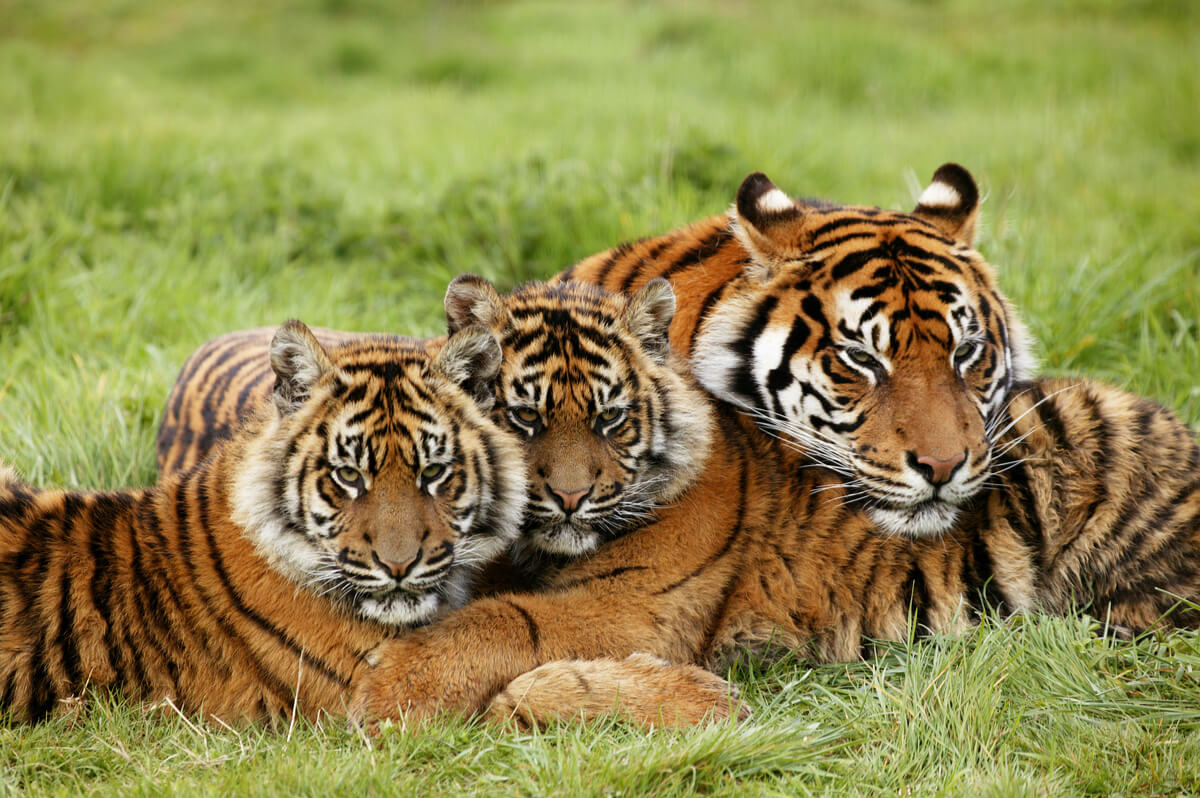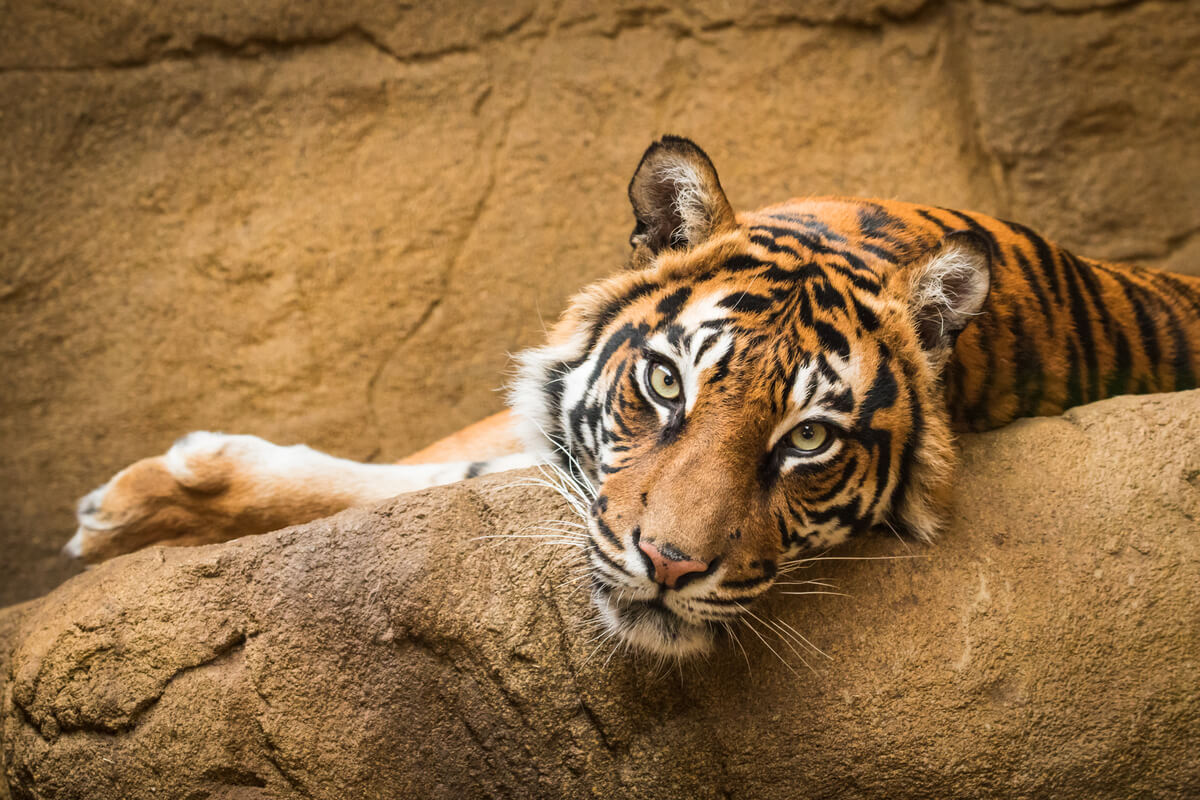Tiger Behavior: Everything You Need to Know!

The impressive bearing of this feline and its delicate movements is a clear sign of how incredible tiger behavior can be. As you delve into it, you’ll discover all the legends linked with it!
If you’re curious about what life is like for this big cat in the wild, here’s a compilation of what we know about its behavior. In addition, finding out more information about it is key to the conservation of the species.
Characteristics of the tiger
The tiger (Panthera tigris) is a member of the Felidae family, belonging to the order Carnivora. There are 6 subspecies of tigers widely distributed throughout the Asian continent.
An adult Bengal tiger is about 3 meters long (nearly 10 feet), including the tail. Males can reach 260 kilograms (570 pounds) and females between 100 and 160 kilos (220 – 350 pounds). However, tigers that live in regions with high temperatures tend to be smaller and thinner than those that live further north.
Like the rest of the felines, their diet is strictly carnivorous. The tiger doesn’t hunt every day, but tries to save energy by catching large prey that allows it to be satiated during variable time intervals.

Tiger character
The tiger is a solitary and territorial mammal that spends most of the day searching for prey within its area. It’s a quiet and subtle hunter that has its peaks of activity during the sunset and at night.
Tiger communication
The olfactory and chemical communication within the tiger behavior is carried out through urine marks on the limits of the territory. Thanks to the chemicals present in their urine, these felids obtain information about the sex, health status, and reproductive times of other specimens. They perform a Flehmen reflex when they detect these substances.
During the Flehmen reflex, animals retract their lips, in order to attract chemical molecules from the environment towards their noses.
Visual cues for marking territory consist of scratches and other marks on trees or in the ground. Their facial expression also expresses different messages when they meet one of the same species and are common to those of other felines in case they’re about to attack or threaten them.
Through sound, tigers can communicate by growling, roaring, meowing, and snorting. It’s the most direct way to convey their state of mind and their intentions. For example, a roar indicates dominance and territoriality, while a moan indicates submission.
Tiger behavior
These basic characteristics of biology and communication are the basis for beginning to study tiger behavior. In the following paragraphs, you can read about their customs in different life scenarios.
Tiger behavior in its natural habitat
Most of a tiger’s day consists of resting and patrolling its territory in search of food. In fact, the presence of tigers in a given environment is directly linked to the existence of healthy populations of large ungulates. These, along with wild pigs, are the main sustenance of the tiger.
Although it’s a hunter with significant weapons to catch prey, its solitary nature forces it to be opportunistic. In this way, a tiger can also be observed consuming small animals if it isn’t too difficult to catch them.
Its hunting method is by ambushing and the vertical striped pattern favors camouflage among the tall grasses. Curiously, its orange color, so contrasted with the green of the vegetation for humans, is perceived as greenish in the vision of its prey. For them, the tiger is perfectly camouflaged.
Tiger behavior in captivity
When a tiger is forced to live in captivity, it loses most of its daily activity, consisting of walking and foraging through stalking and following scent trails. Inside a compound, in which it’s provided with food and has nothing to do but rest, its mental health suffers.
In tiger behavior, it’s common to observe stereotypes, as with any other wild cat in captivity, especially when walking. They also tend to decrease their activity a lot and show signs of lethargy, as they don’t have to move to feed.
Reproductive behavior
The study of their reproductive behavior in captivity hasn’t been studied as much as we would like, since their wide distribution makes their location and monitoring difficult. For this reason, most of the data is collected from specimens in captivity.
Female tigers enter estrus every 3-9 weeks, at which time they’re receptive for 3-6 days. At that time, a male must locate her to woo her and mate. This species reaches sexual maturity at 4 years.
A female should consume twice as much food when her young are lactating. Therefore, in places where human action reduces the number of prey, tiger populations end up being unsustainable.
Infanticide by males is occasionally seen, resulting in a useful strategy for the female to re-enter heat and perpetuate her genes. If they survive, the male offspring eventually migrate and seek another territory. Females, on the other hand, tend to occupy areas close to their mother’s.
Relationship of the tiger and the human
Despite its reputation as a killer and hunter of humans, we are not part of a tiger’s diet. The reported cases of attacks on people usually occur when human populations overlap with the territories of these felines.
In addition, if a tiger hunts a human for food, it usually means that it has some kind of difficulty in catching its true prey, such as advanced age or some disease. These cats can also attack if they feel threatened, especially females with young.
On the other hand, note that humans have hunted tigers to near extinction. Whether they threaten livestock farms, trade in body parts, or traffic in specimens, humans have hunted tigers since time immemorial.
Can you tame a tiger?
No. The tiger is a wild, solitary feline, with a hunting instinct and it must live in its natural environment. For such an animal to become docile usually requires physically and mentally mistreating it until it “breaks down”. Its behavior in captivity is governed solely by fear and learned helplessness.

Like all predators, it fulfills an inescapable function in ecosystems. Therefore, preventing its disappearance is necessary in order to maintain the environments it inhabits in the long term.
All cited sources were thoroughly reviewed by our team to ensure their quality, reliability, currency, and validity. The bibliography of this article was considered reliable and of academic or scientific accuracy.
- Panthera tigris (tiger). (2021). Animal Diversity Web. https://animaldiversity.org/accounts/Panthera_tigris/
- Goodrich, J., Lynam, A., Miquelle, D., Wibisono, H., Kawanishi, K., Pattanavibool, A., Htun, S., Tempa, T., Karki, J., Jhala, Y. & Karanth, U. 2015. Panthera tigris. The IUCN Red List of Threatened Species 2015: e.T15955A50659951. https://dx.doi.org/10.2305/IUCN.UK.2015-2.RLTS.T15955A50659951.en. Downloaded on 12 July 2021.
- Fennell, J. G., Talas, L., Baddeley, R. J., Cuthill, I. C., & Scott-Samuel, N. E. (2019). Optimizing colour for camouflage and visibility using deep learning: the effects of the environment and the observer’s visual system. Journal of The Royal Society Interface, 16(154), 20190183.